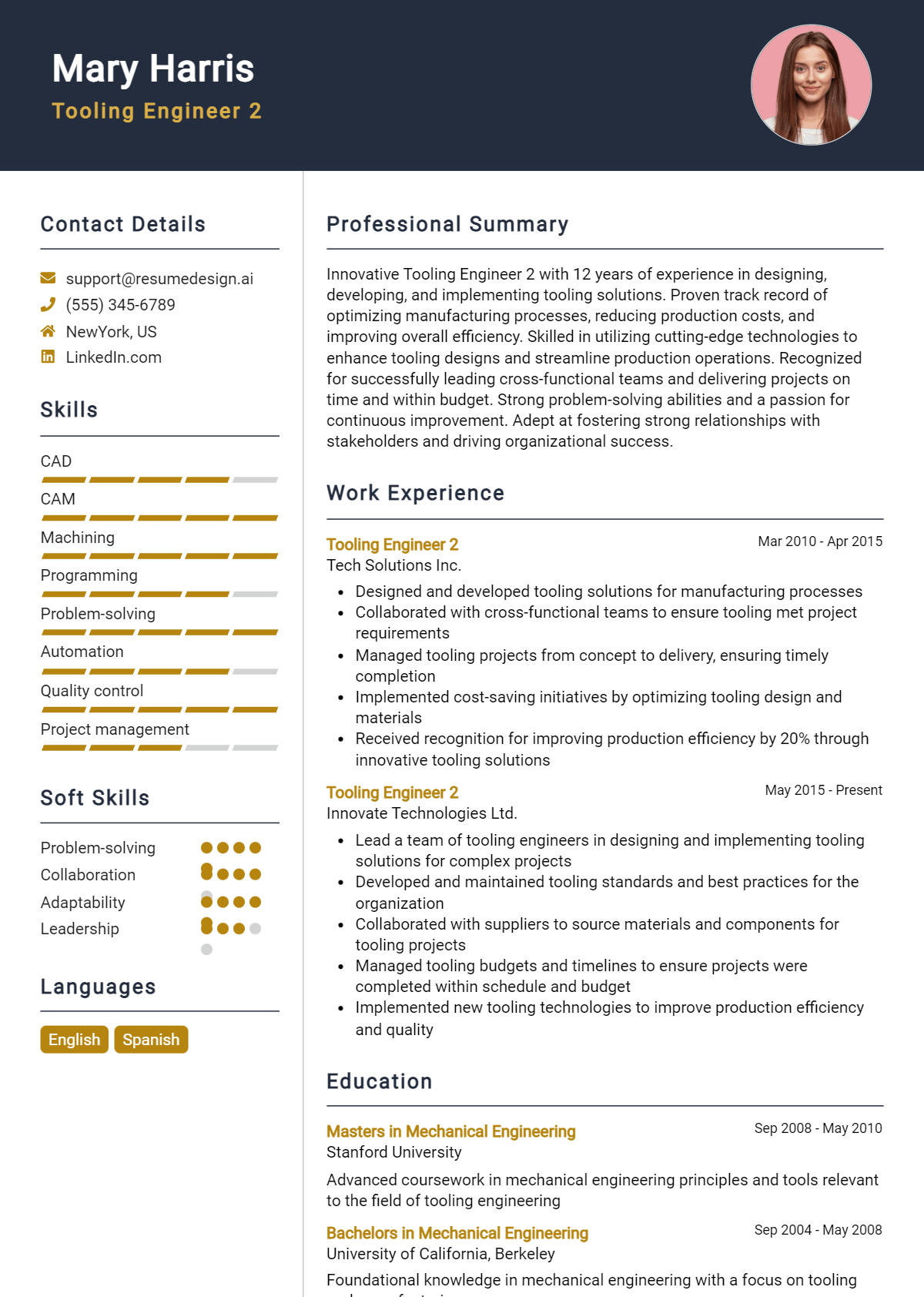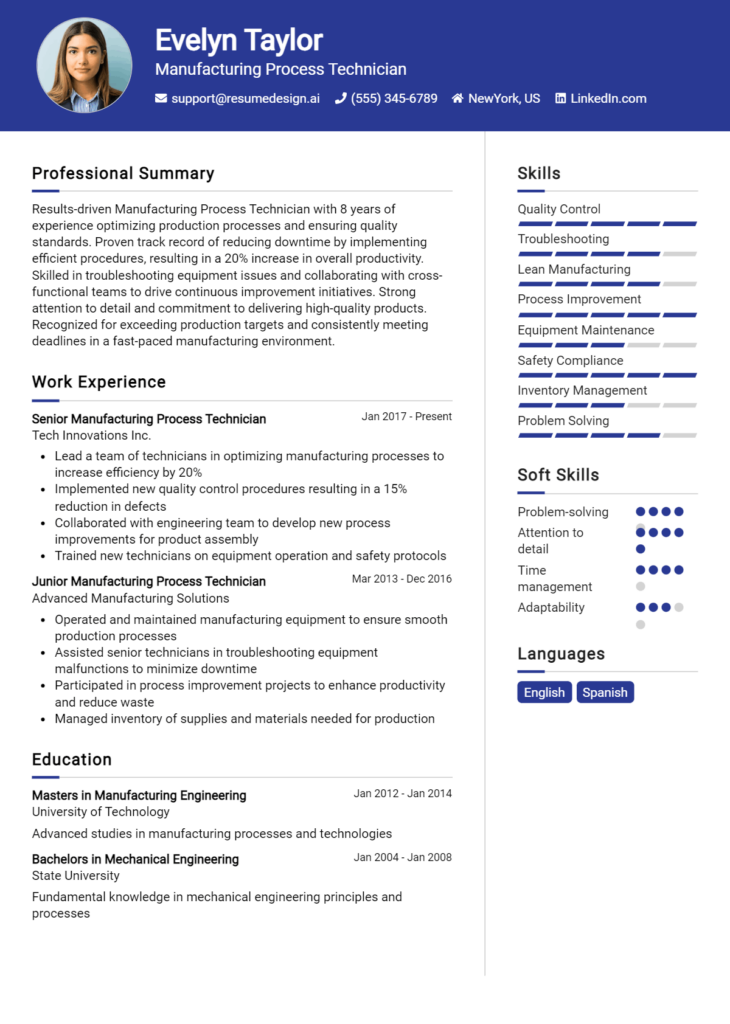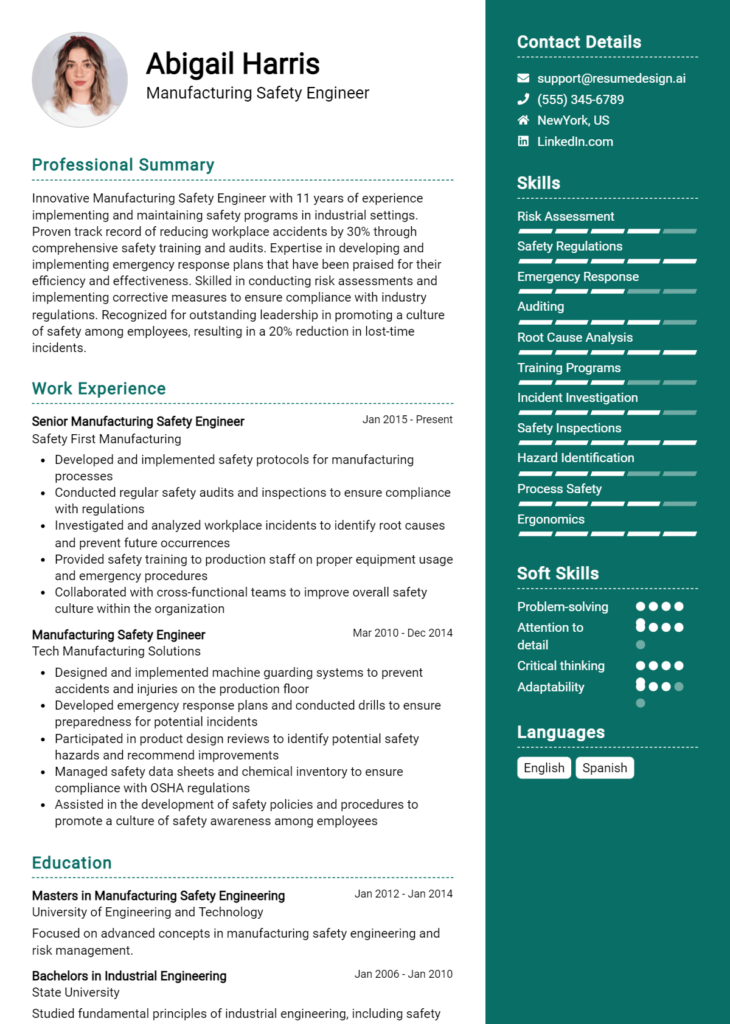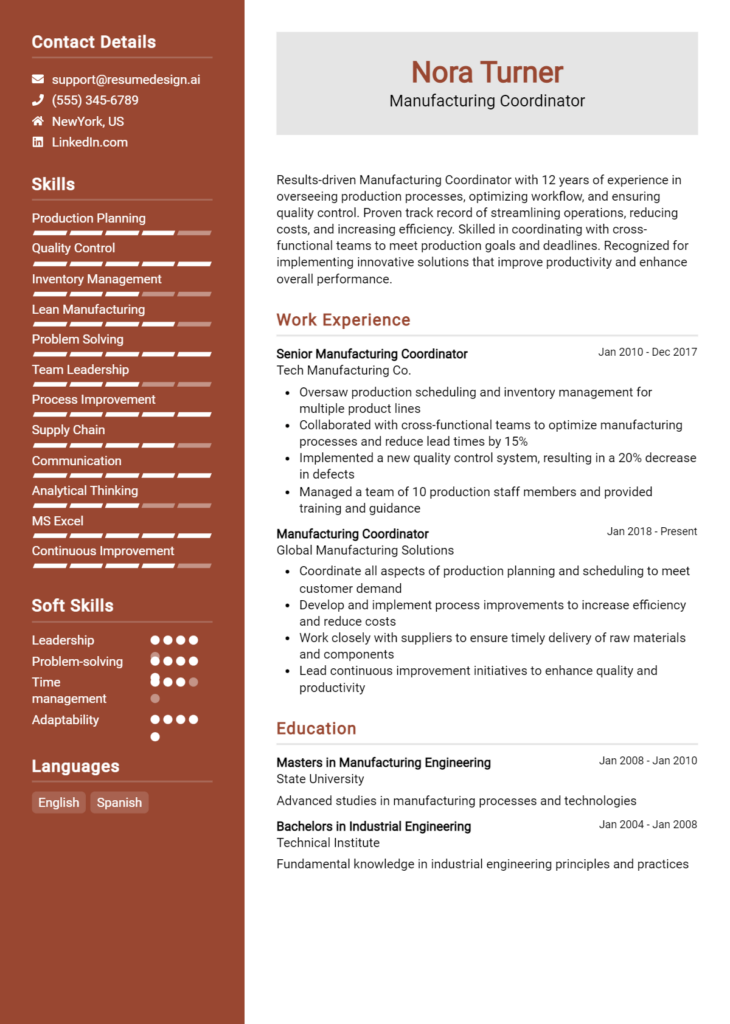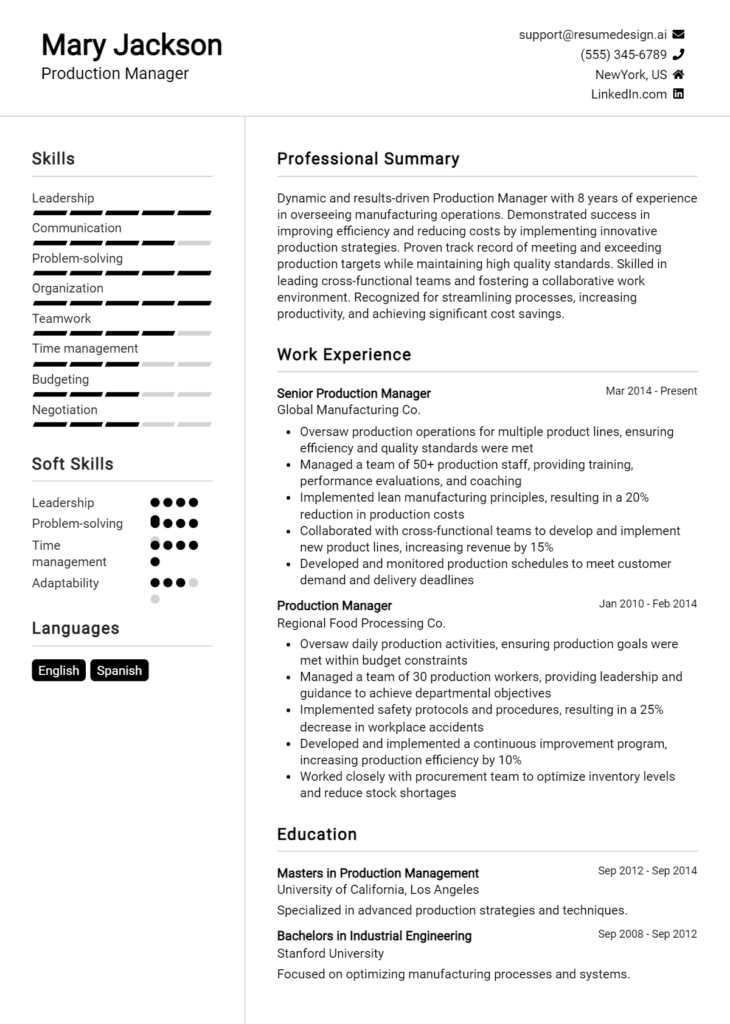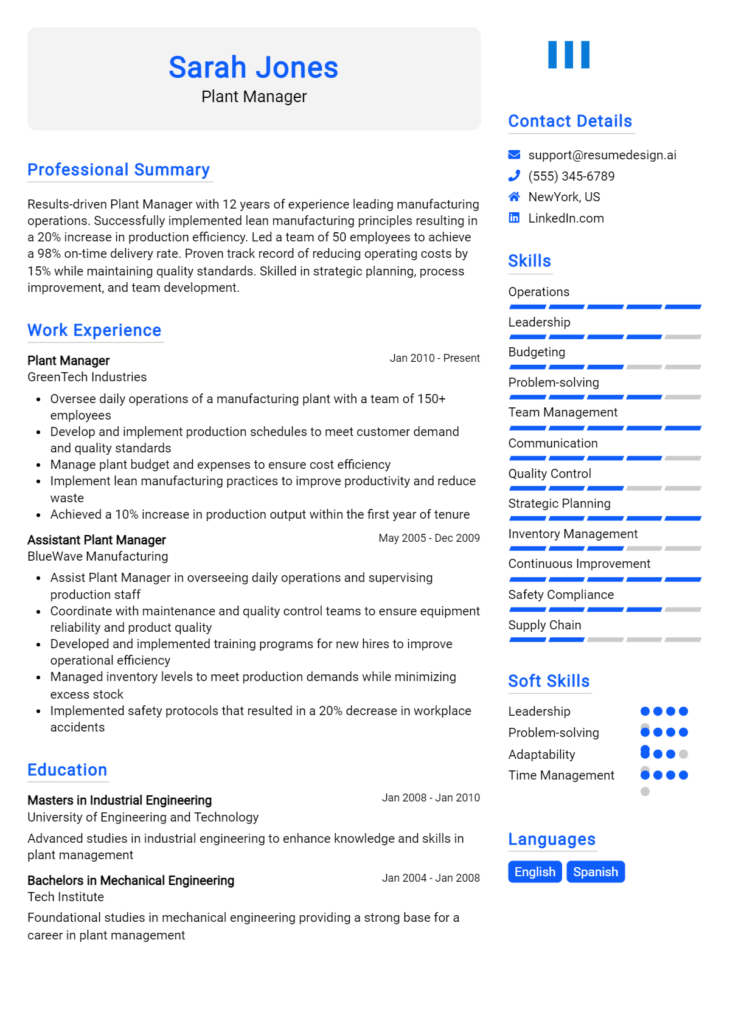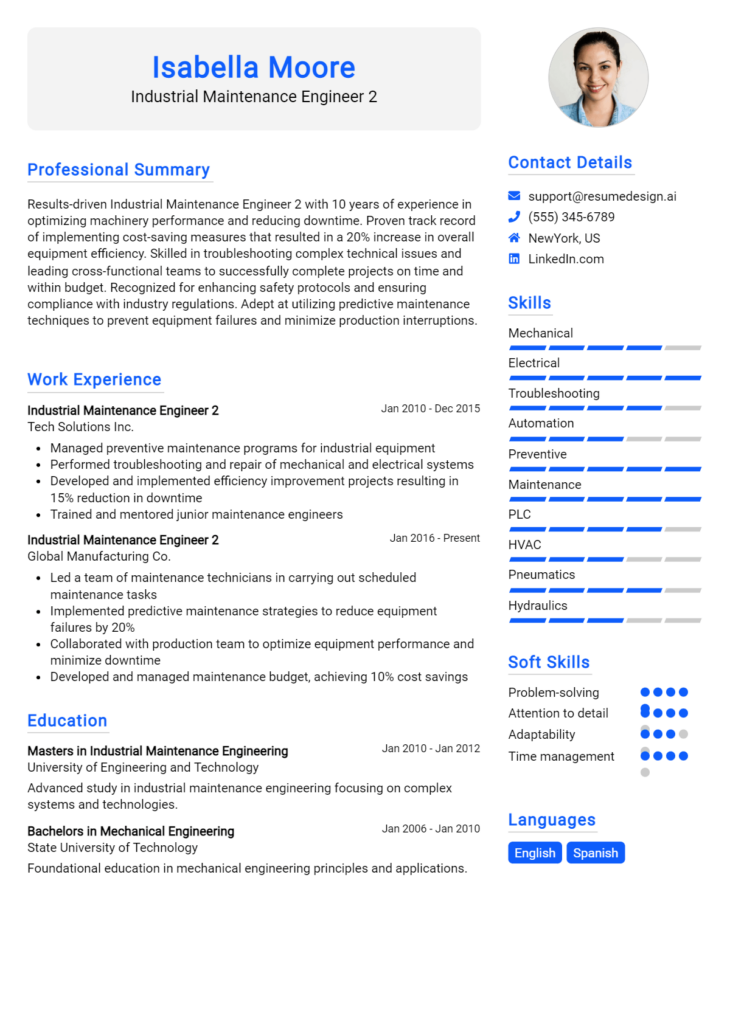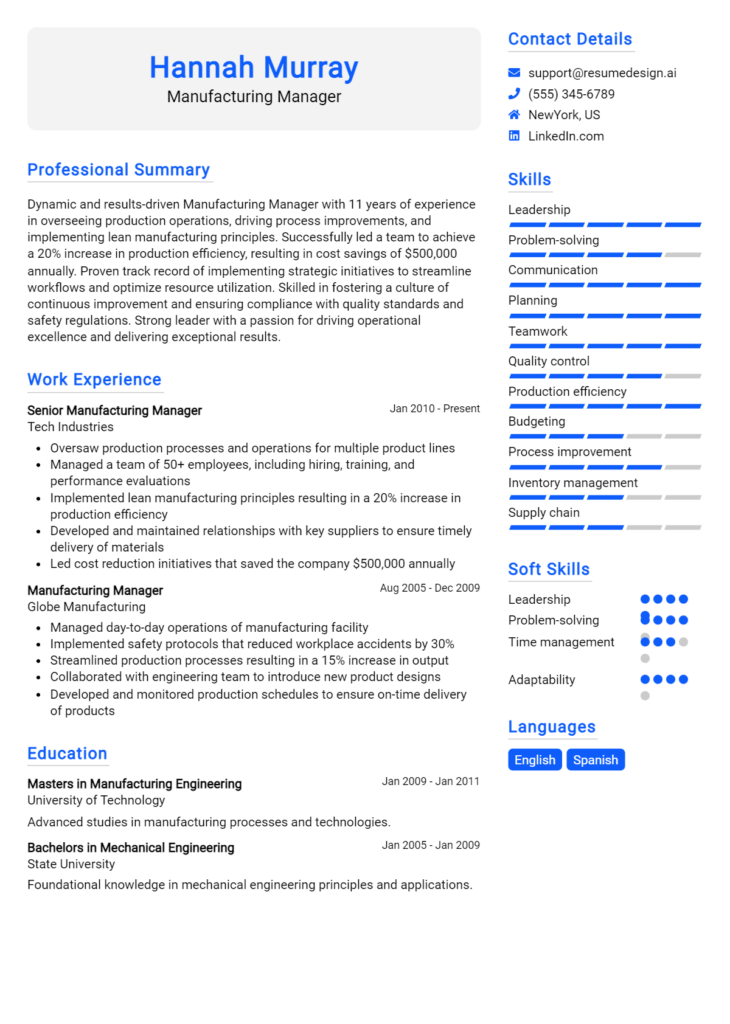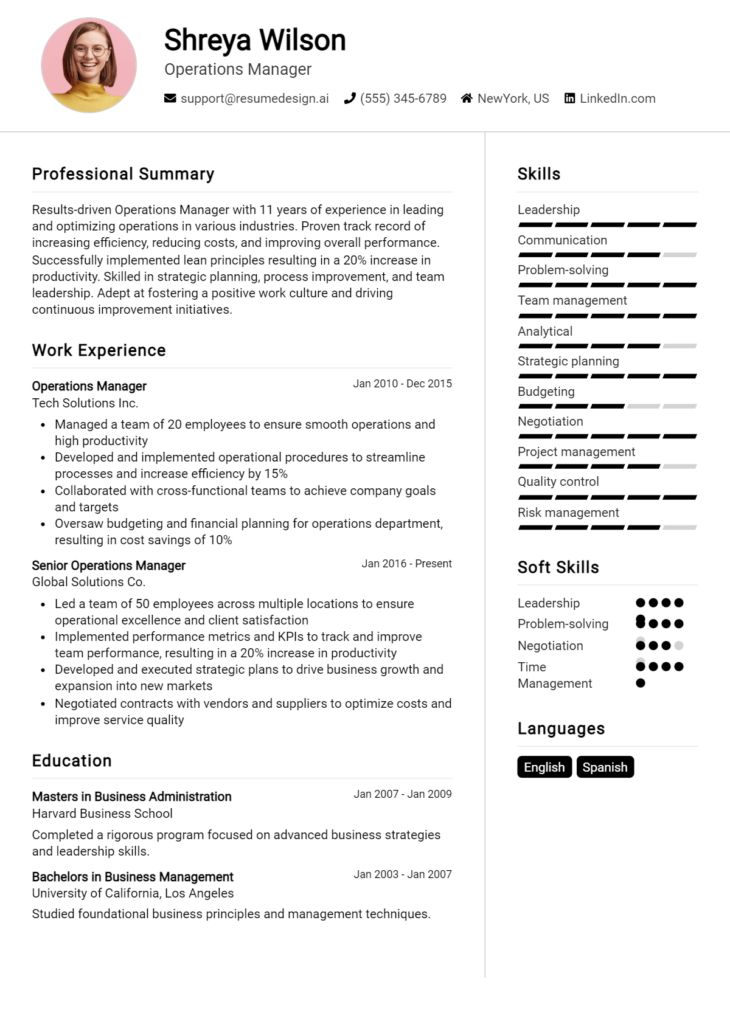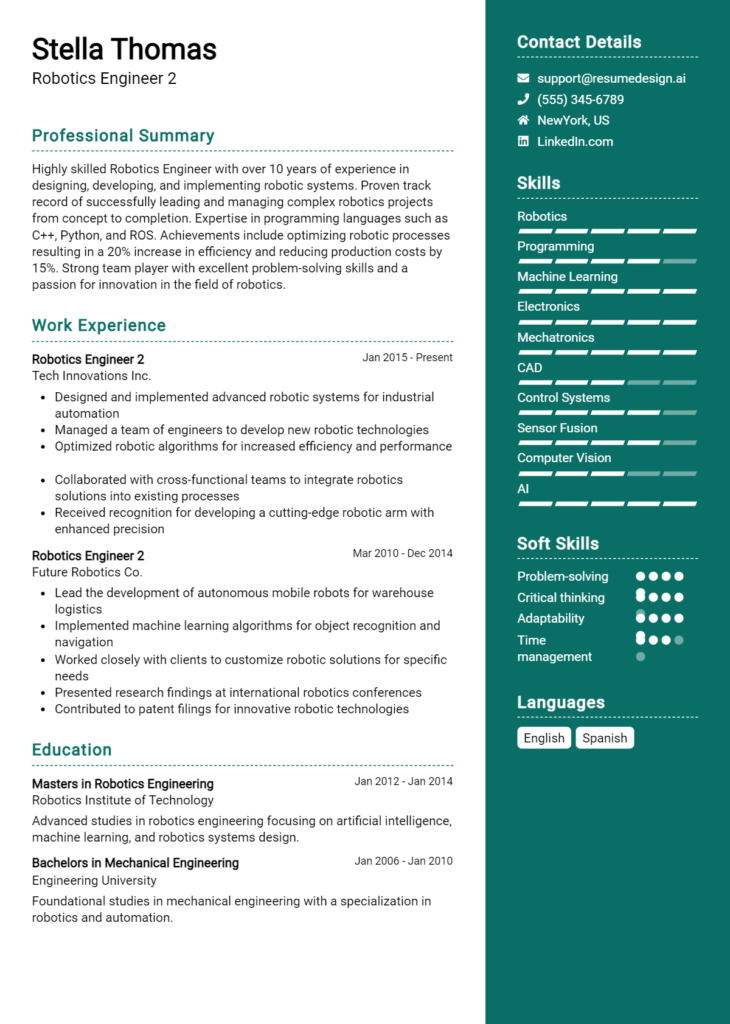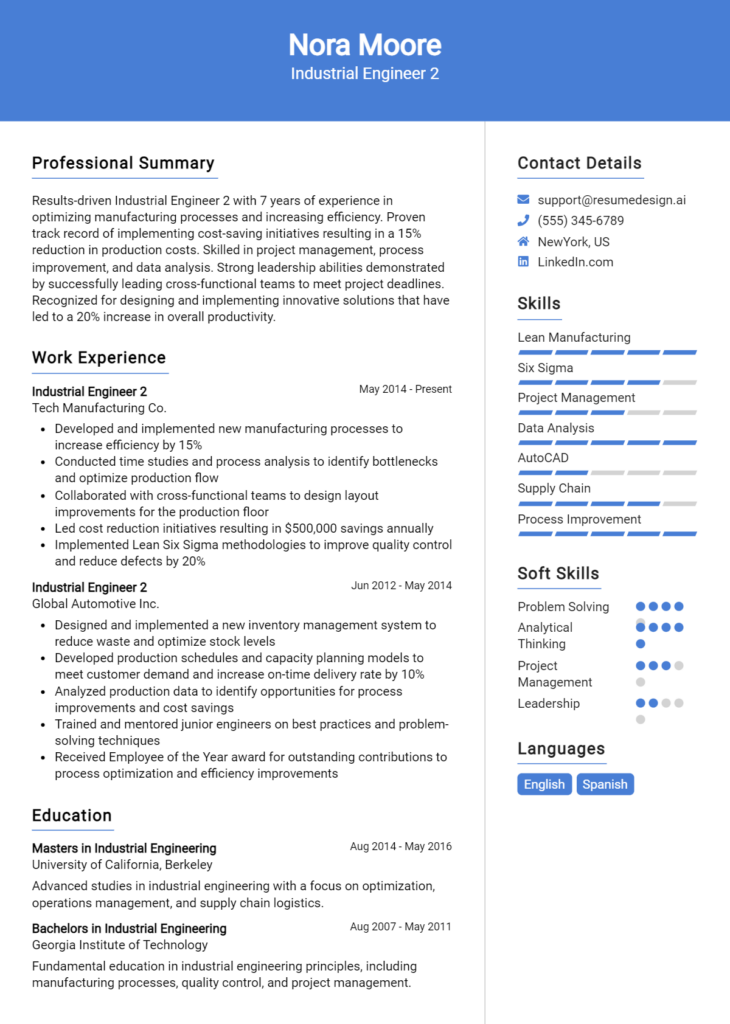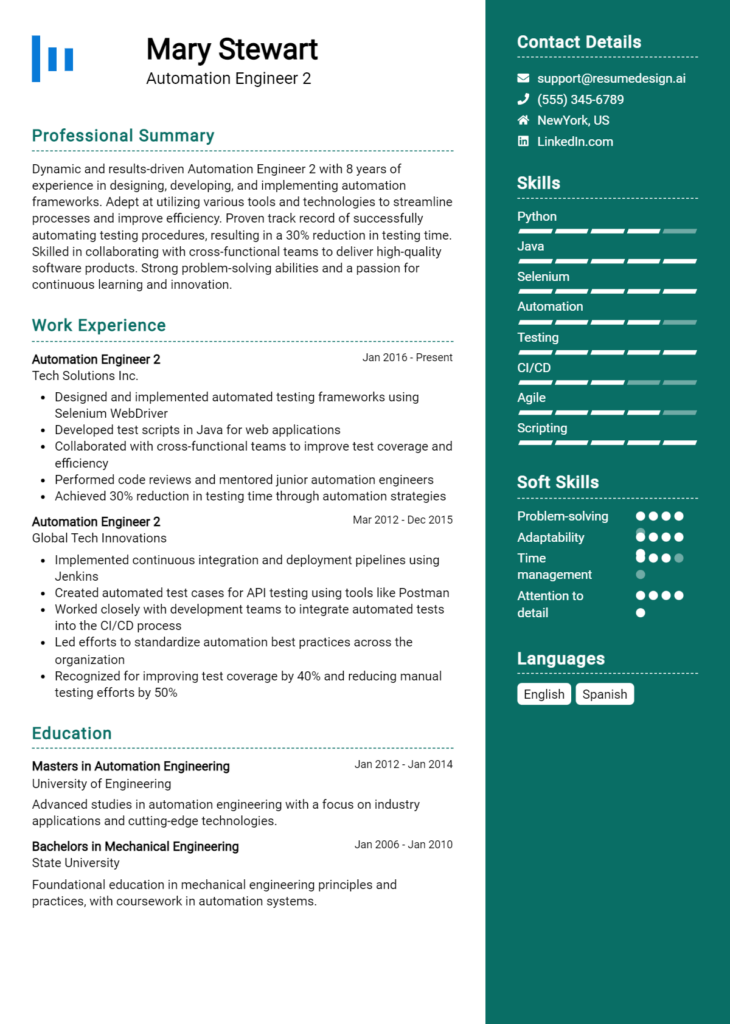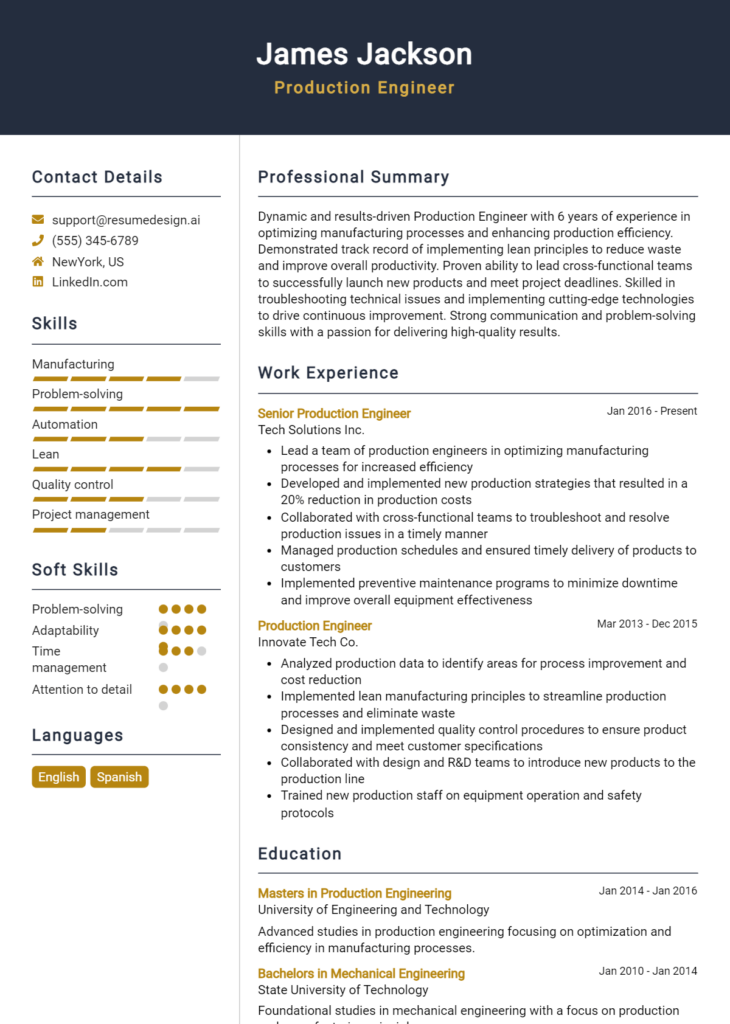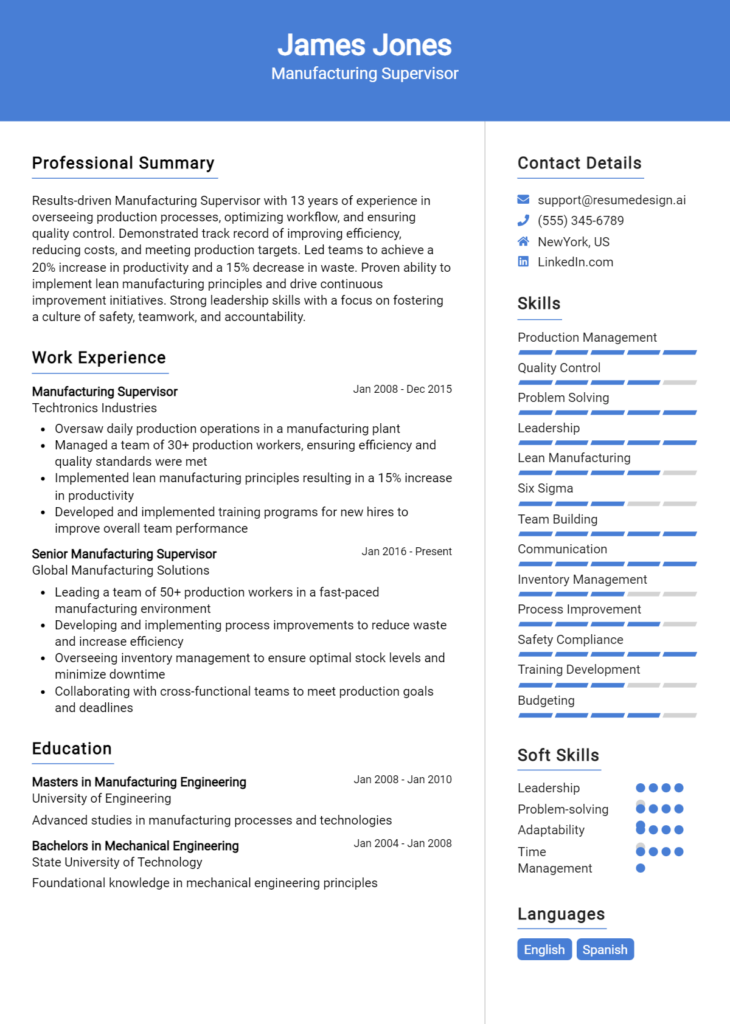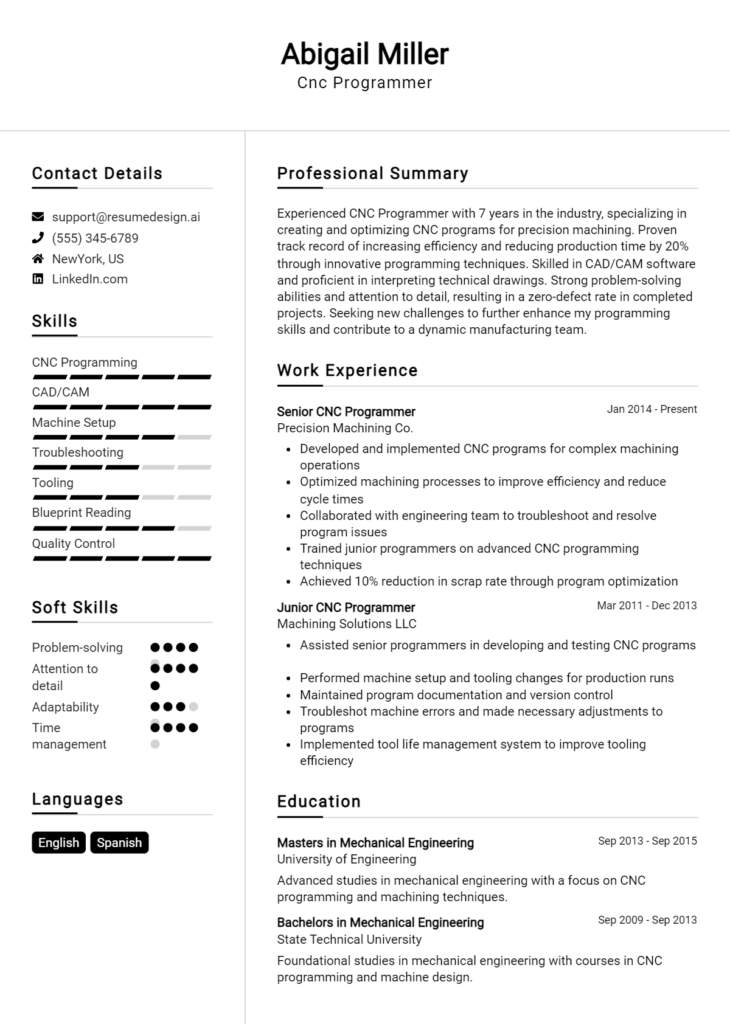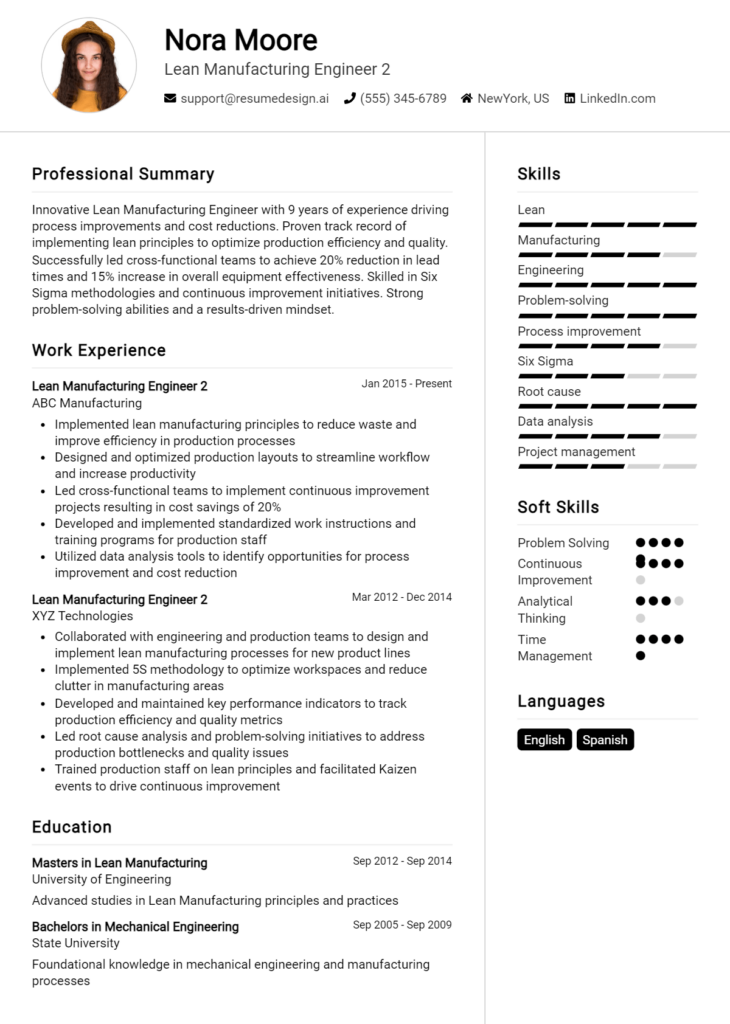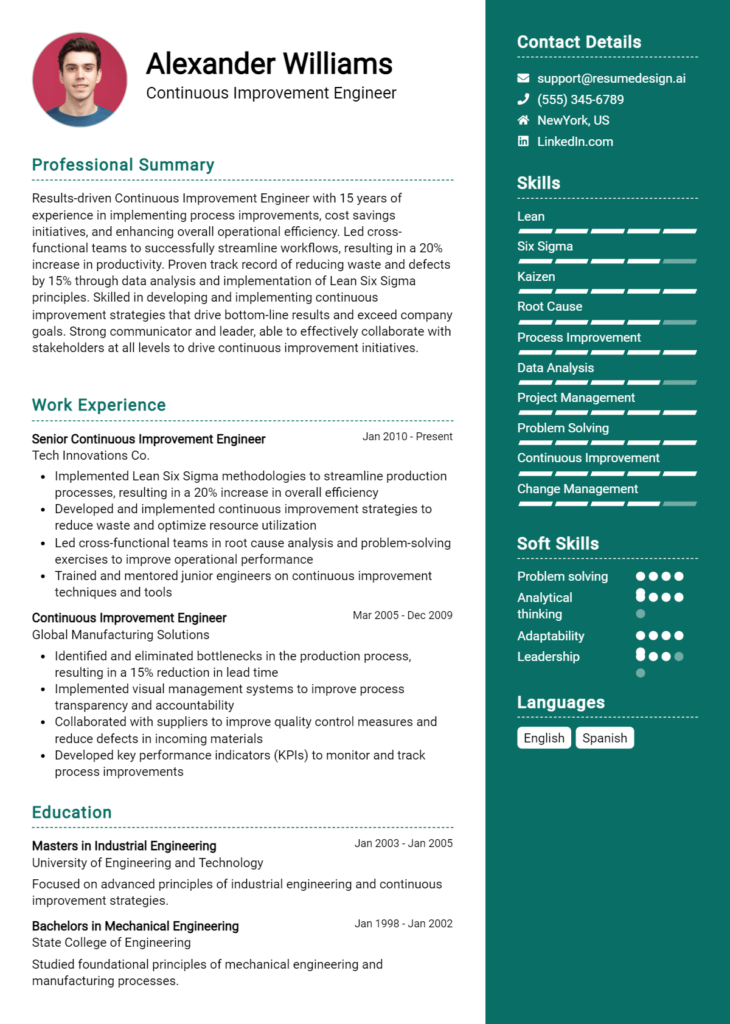Tooling Engineer Core Responsibilities
A Tooling Engineer is essential in optimizing manufacturing processes by designing, developing, and maintaining tooling and fixtures. This role requires strong technical knowledge, operational insight, and problem-solving capabilities to collaborate effectively across departments such as production, quality assurance, and R&D. By ensuring tools meet production requirements, Tooling Engineers contribute significantly to organizational goals. A well-structured resume can highlight these skills, showcasing a candidate's ability to drive efficiency and innovation within the company.
Common Responsibilities Listed on Tooling Engineer Resume
- Design and develop tooling for manufacturing processes.
- Conduct feasibility studies for new tooling projects.
- Collaborate with cross-functional teams to improve production efficiency.
- Analyze and troubleshoot tooling-related issues on the production floor.
- Maintain documentation for tooling specifications and changes.
- Implement cost-reduction initiatives related to tooling.
- Test and validate new tooling designs for effectiveness.
- Provide training and support to production staff on tooling usage.
- Monitor tooling performance and recommend improvements.
- Ensure compliance with safety and industry standards.
- Manage tooling inventory and maintenance schedules.
High-Level Resume Tips for Tooling Engineer Professionals
In the competitive field of tooling engineering, a well-crafted resume serves as a crucial tool for making a strong first impression on potential employers. It is not just a document; it is a marketing tool that showcases your skills, achievements, and professional journey. A thoughtfully designed resume can effectively communicate your qualifications and demonstrate how you can contribute to a company's success. This guide will provide practical and actionable resume tips specifically tailored for Tooling Engineer professionals, helping you stand out in a crowded job market.
Top Resume Tips for Tooling Engineer Professionals
- Tailor your resume to the specific job description by incorporating relevant keywords from the posting.
- Highlight your education and certifications, especially those related to tooling design and engineering.
- Showcase your relevant experience, detailing specific projects where you utilized tooling techniques or technologies.
- Quantify your achievements by including metrics, such as cost savings, efficiency improvements, or production increases.
- Emphasize industry-specific skills, such as CAD software proficiency, materials science knowledge, and manufacturing processes.
- Include a summary statement at the beginning of your resume that encapsulates your expertise and career goals.
- Utilize bullet points for clarity and to make your accomplishments easy to read and digest.
- Incorporate any relevant internships or cooperative education experiences that demonstrate your hands-on skills.
- Keep the format clean and professional, ensuring consistency in font and layout to enhance readability.
- Proofread your resume meticulously to eliminate any grammatical errors or typos, as attention to detail is crucial in engineering roles.
By implementing these tips into your resume, you can significantly increase your chances of landing a job in the Tooling Engineer field. A compelling resume not only highlights your qualifications but also conveys your professionalism and attention to detail, qualities that are essential in engineering roles. Take the time to craft a resume that truly represents your skills and achievements, and watch as it opens doors to exciting career opportunities.
Why Resume Headlines & Titles are Important for Tooling Engineer
In the competitive field of engineering, particularly for Tooling Engineers, a resume headline or title plays a crucial role in capturing the attention of hiring managers. A strong headline serves as a powerful first impression, summarizing a candidate's key qualifications in a concise and impactful manner. It should reflect relevant skills, experiences, and achievements that align directly with the job being applied for. By crafting a compelling resume headline, candidates can effectively highlight their suitability for the role, making it easier for hiring managers to recognize their potential contributions at a glance.
Best Practices for Crafting Resume Headlines for Tooling Engineer
- Keep it concise: Aim for a headline that is brief yet informative, ideally under 10 words.
- Be role-specific: Tailor your headline to reflect the specific tooling engineer position you are applying for.
- Highlight key skills: Use keywords that showcase your essential skills and areas of expertise relevant to tooling engineering.
- Focus on achievements: Include accomplishments or measurable outcomes that demonstrate your impact in previous roles.
- Use action-oriented language: Start with strong action verbs to convey a sense of proactivity and confidence.
- Avoid jargon: Ensure the language used is accessible and understandable to a broad audience, including HR professionals.
- Reflect industry standards: Incorporate industry-specific terms that resonate with hiring managers in the engineering field.
- Revise for clarity: Review and refine your headline to ensure it communicates your value succinctly and effectively.
Example Resume Headlines for Tooling Engineer
Strong Resume Headlines
Innovative Tooling Engineer with 10+ Years of Experience in Precision Manufacturing
Results-Driven Tooling Specialist Focused on Cost Reduction and Efficiency Improvements
Expert Tooling Engineer Skilled in CAD Design and Process Optimization
Weak Resume Headlines
Engineer Looking for Opportunities
Tooling Professional
The strong headlines are effective because they encapsulate the applicant's qualifications, experience, and specific skills relevant to the tooling engineering role. They provide a clear picture of what the candidate brings to the table, making it easy for hiring managers to see their fit for the position. In contrast, the weak headlines fail to make an impact due to their vagueness and lack of specificity. They do not convey any unique strengths or insights into the candidate's capabilities, leading to a missed opportunity to stand out in a competitive job market.
Writing an Exceptional Tooling Engineer Resume Summary
A well-crafted resume summary is crucial for a Tooling Engineer as it serves as the first impression for hiring managers. This brief yet significant section quickly captures attention by highlighting key skills, relevant experience, and notable accomplishments tailored specifically to the job role. A strong summary should be concise and impactful, effectively encapsulating the candidate's qualifications in a way that resonates with the employer’s needs and the specific job they are applying for. By doing so, it sets the stage for the rest of the resume and enhances the candidate's chances of making a memorable impact.
Best Practices for Writing a Tooling Engineer Resume Summary
- Quantify Achievements: Use numbers to demonstrate the impact of your work, such as cost savings or efficiency improvements.
- Focus on Relevant Skills: Highlight technical and soft skills that are directly applicable to the tooling engineering role.
- Tailor for the Job Description: Customize your summary to align with the specific requirements and keywords from the job posting.
- Be Concise: Aim for 3-5 sentences that deliver maximum information in a succinct manner.
- Use Action Words: Start sentences with strong action verbs that convey impact and initiative.
- Showcase Industry Knowledge: Reference any specific technologies, processes, or methodologies relevant to tooling engineering.
- Highlight Problem-Solving Abilities: Mention specific challenges you’ve addressed and the results achieved.
- Maintain Professional Tone: Ensure the summary reflects a professional demeanor appropriate for the engineering field.
Example Tooling Engineer Resume Summaries
Strong Resume Summaries
Results-driven Tooling Engineer with over 7 years of experience in designing and optimizing manufacturing processes. Successfully led a project that reduced tooling costs by 30% while improving production efficiency by 25%. Proficient in CAD software and lean manufacturing principles.
Detail-oriented Tooling Engineer with a proven track record of developing innovative tooling solutions that enhance product quality. Spearheaded the implementation of a new tooling system that decreased cycle time by 15% and resulted in a 20% increase in output.
Experienced Tooling Engineer specializing in precision machining and injection molding. Achieved a 40% reduction in scrap rates through effective tooling design modifications and rigorous quality control measures. Strong communicator with a focus on cross-functional collaboration.
Weak Resume Summaries
I am a Tooling Engineer with experience in the manufacturing industry. I have worked on various projects and have some skills related to tooling.
Tooling Engineer seeking a new opportunity. I have knowledge of engineering principles and some experience in tooling design.
The strong resume summaries are considered effective because they provide concrete examples of achievements, quantify results, and align closely with the typical requirements for a Tooling Engineer. They demonstrate not just experience, but the impact of that experience, making the candidate stand out. In contrast, the weak summaries are vague and lack specific details or quantifiable outcomes, making it difficult for hiring managers to gauge the candidate's capabilities or relevance to the role.
Work Experience Section for Tooling Engineer Resume
The work experience section of a Tooling Engineer resume is critical as it serves as a testament to the candidate's technical skills, leadership capabilities, and their ability to deliver high-quality products within the tooling industry. This section not only highlights the candidate's hands-on experience but also provides insights into their project management abilities and collaboration with cross-functional teams. By quantifying achievements and aligning past experiences with industry standards, candidates can effectively demonstrate their value and suitability for potential employers.
Best Practices for Tooling Engineer Work Experience
- Clearly outline your technical skills and how they were applied in previous roles.
- Use quantifiable metrics to illustrate your achievements, such as cost savings, efficiency improvements, or project completions.
- Highlight leadership experiences, including team management and project supervision.
- Demonstrate collaboration with other departments or stakeholders to showcase teamwork and communication skills.
- Align your experiences with industry standards and technologies that are relevant to the role you are applying for.
- Use action verbs to begin each bullet point, enhancing the impact of your contributions.
- Tailor your experiences to match the job description, ensuring relevance and clarity.
- Include any certifications or specialized training that enhance your qualifications.
Example Work Experiences for Tooling Engineer
Strong Experiences
- Led a team of 8 engineers to design and implement a new tooling system that reduced production costs by 25% and improved efficiency by 15% within the first quarter.
- Developed a quality control process for tooling operations, resulting in a 30% decrease in defects and a 20% increase in customer satisfaction ratings.
- Collaborated with cross-functional teams to launch a new product line, successfully delivering the project 2 months ahead of schedule, which contributed to a 10% increase in annual revenue.
- Managed a tooling budget of $500,000, optimizing resource allocation and achieving a 15% reduction in expenses while maintaining high-quality standards.
Weak Experiences
- Worked on various tooling projects with minimal details provided.
- Assisted in the development of tooling processes without quantifying any results.
- Participated in team meetings and discussions, but did not take a leadership role.
- Helped maintain equipment and tools with no specific accomplishments listed.
The examples provided are considered strong because they quantify achievements, demonstrate clear leadership, and showcase collaboration with measurable results. In contrast, the weak experiences lack specific details, achievements, and quantifiable outcomes, making them less impactful and failing to convey the candidate's true capabilities and contributions in previous roles.
Education and Certifications Section for Tooling Engineer Resume
The education and certifications section of a Tooling Engineer resume plays a crucial role in showcasing a candidate's academic background and professional achievements. This section not only highlights relevant degrees but also emphasizes industry-specific certifications that validate the candidate's expertise in tooling design, manufacturing processes, and engineering principles. By including pertinent coursework and specialized training, candidates can demonstrate their commitment to continuous learning and professional development, significantly enhancing their credibility and alignment with the job role they are pursuing.
Best Practices for Tooling Engineer Education and Certifications
- Focus on relevant degrees, such as Mechanical Engineering or Manufacturing Engineering.
- Include industry-recognized certifications, like Certified Manufacturing Engineer (CMfgE) or Tooling Engineer Certification.
- List pertinent coursework that directly relates to tooling, such as CAD design or materials science.
- Highlight any specialized training in tooling processes, CNC machining, or automation technologies.
- Ensure all entries are up-to-date and reflect current industry standards.
- Consider including professional development courses or workshops to showcase ongoing learning.
- Use clear formatting to distinguish between degrees, certifications, and training for easy readability.
- Tailor the section to align with the specific job description, emphasizing the most relevant qualifications.
Example Education and Certifications for Tooling Engineer
Strong Examples
- Bachelor of Science in Mechanical Engineering, ABC University, 2020
- Certified Manufacturing Engineer (CMfgE), Society of Manufacturing Engineers, 2022
- Advanced CAD Design Course, XYZ Institute, 2021
- Tooling and Fixture Design Certification, National Institute of Standards and Technology, 2023
Weak Examples
- Bachelor of Arts in English Literature, DEF College, 2019
- Basic Computer Skills Course, 2018
- Certification in Project Management (not specific to engineering), 2020
- High School Diploma, GHI High School, 2015
The strong examples provided are considered effective because they directly relate to the field of tooling engineering, showcasing both relevant educational qualifications and industry-recognized certifications that indicate a high level of expertise. In contrast, the weak examples fail to align with the specialized requirements of the Tooling Engineer role, either due to their unrelated nature or because they do not reflect the necessary technical skills and knowledge that employers seek in this field.
Top Skills & Keywords for Tooling Engineer Resume
As a Tooling Engineer, possessing the right skills is crucial for creating efficient tooling solutions that meet production requirements and enhance product quality. A well-crafted resume should highlight both hard and soft skills, demonstrating a candidate's technical expertise and interpersonal abilities. These skills not only reflect a candidate's proficiency in tooling design and manufacturing processes but also their capability to collaborate effectively within a team, manage projects, and solve complex problems. Emphasizing these skills can significantly improve a Tooling Engineer's chances of standing out to potential employers and securing the desired position.
Top Hard & Soft Skills for Tooling Engineer
Soft Skills
- Problem-solving
- Communication
- Team collaboration
- Time management
- Adaptability
- Attention to detail
- Critical thinking
- Project management
- Creativity
- Leadership
Hard Skills
- CAD software proficiency (e.g., SolidWorks, AutoCAD)
- CNC programming
- Material science knowledge
- Tool design and development
- Prototyping techniques
- Quality assurance and control
- Manufacturing process optimization
- Injection molding expertise
- Tolerance analysis
- Statistical process control (SPC)
By focusing on these essential skills and showcasing relevant work experience, Tooling Engineers can effectively convey their qualifications and readiness for the challenges of the role.
Stand Out with a Winning Tooling Engineer Cover Letter
Dear [Hiring Manager's Name],
I am writing to express my enthusiasm for the Tooling Engineer position at [Company Name] as advertised on [where you found the job listing]. With a robust background in tooling design and manufacturing processes, coupled with my passion for innovation and efficiency, I am excited about the opportunity to contribute to your team. My experience in developing precision tooling solutions aligns well with your commitment to quality and excellence in manufacturing.
Throughout my career, I have successfully managed projects from concept through to production, ensuring that all tooling meets the stringent requirements of both functionality and manufacturability. At [Previous Company Name], I played a pivotal role in a project that reduced tooling costs by 20% while improving production speed by 15%. By implementing advanced design techniques and collaborating closely with cross-functional teams, I was able to streamline processes and enhance overall productivity. My proficiency in CAD software and deep understanding of various manufacturing techniques allow me to create innovative tooling designs that support both cost-efficiency and high-quality output.
I am particularly impressed by [Company Name]'s dedication to sustainable manufacturing practices and continuous improvement. I believe my proactive approach and commitment to leveraging technology for effective tooling solutions will make a significant impact in your organization. I am eager to bring my technical expertise, strong problem-solving skills, and collaborative mindset to your team, ensuring that we not only meet but exceed project goals.
Thank you for considering my application. I look forward to the opportunity to discuss how my experience and vision for tooling engineering can contribute to the ongoing success of [Company Name]. I am excited about the possibility of working together to develop innovative solutions that drive efficiency and excellence in your manufacturing processes.
Sincerely,
[Your Name]
[Your Phone Number]
[Your Email Address]
[Your LinkedIn Profile (if applicable)]
Common Mistakes to Avoid in a Tooling Engineer Resume
When crafting a resume for a Tooling Engineer position, it's crucial to present your skills and experience effectively to stand out in a competitive job market. However, many candidates make common mistakes that can undermine their chances of securing an interview. Understanding these pitfalls can help you create a more compelling resume that accurately reflects your qualifications and expertise.
Neglecting Keywords: Failing to include industry-specific keywords can make your resume less likely to pass through applicant tracking systems (ATS). Tailor your resume to each job description by incorporating relevant terms.
Overloading with Technical Jargon: While technical knowledge is important, using too much jargon can alienate hiring managers who may not be familiar with every term. Aim for clarity and balance in your language.
Vague Job Descriptions: Providing generic descriptions of past roles can make it hard for employers to gauge your contributions. Use specific examples and quantifiable achievements to illustrate your impact in previous positions.
Ignoring Soft Skills: Tooling Engineers often work in teams and must communicate effectively. Omitting soft skills, such as teamwork and problem-solving, can give an incomplete picture of your capabilities.
Inconsistent Formatting: A cluttered or inconsistent resume can distract from the content. Maintain a clean, professional format with uniform font styles, sizes, and spacing to enhance readability.
Lack of Customization: Sending out a generic resume can signal a lack of interest in the specific role. Customize your resume for each application to reflect how your experience aligns with the job requirements.
Omitting Certifications and Training: Tooling Engineers often require specific certifications or training. Failing to list relevant qualifications can make your resume less competitive.
Neglecting Proofreading: Spelling and grammatical errors can create a negative impression. Thoroughly proofread your resume to ensure it is free from mistakes, as these can suggest a lack of attention to detail.
Conclusion
As a Tooling Engineer, your expertise in designing, developing, and maintaining tooling systems is crucial to the manufacturing process. Throughout this article, we explored the essential skills and qualifications necessary for this role, including proficiency in CAD software, an understanding of materials and manufacturing processes, and strong problem-solving abilities. We also highlighted the importance of continuous learning and staying up-to-date with industry advancements to enhance your effectiveness in the field.
In conclusion, ensuring that your resume accurately reflects your skills and experiences as a Tooling Engineer is vital to standing out in a competitive job market. We encourage you to take a moment to review your Tooling Engineer resume and make any necessary updates.
To assist you in this process, we offer a variety of resources:
- Check out our resume templates for a polished design.
- Use our resume builder to create a tailored resume effortlessly.
- Browse through resume examples for inspiration and best practices.
- Don't forget to prepare a compelling cover letter with our cover letter templates.
Take action today to ensure your resume stands out and effectively showcases your qualifications as a Tooling Engineer!

